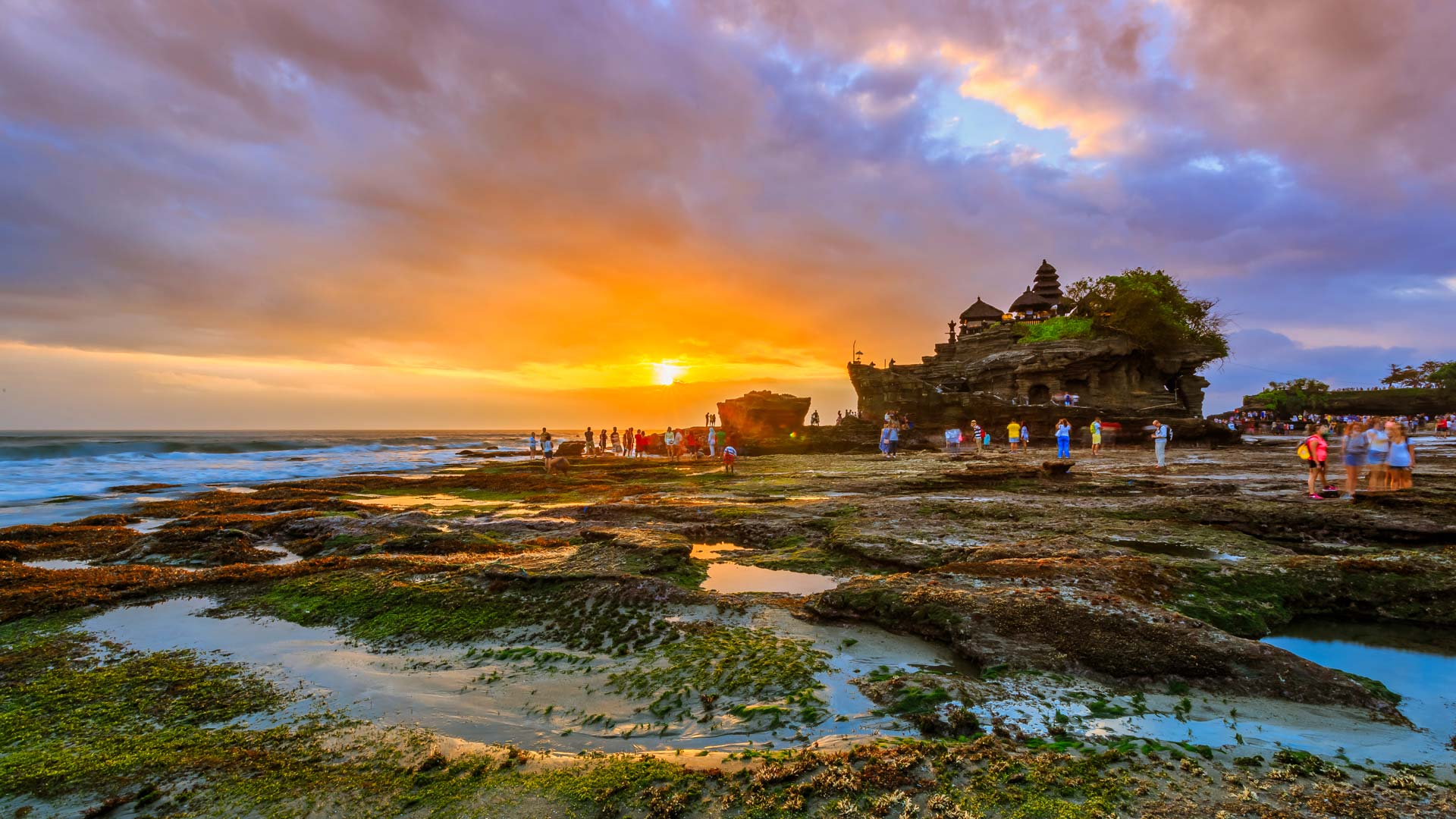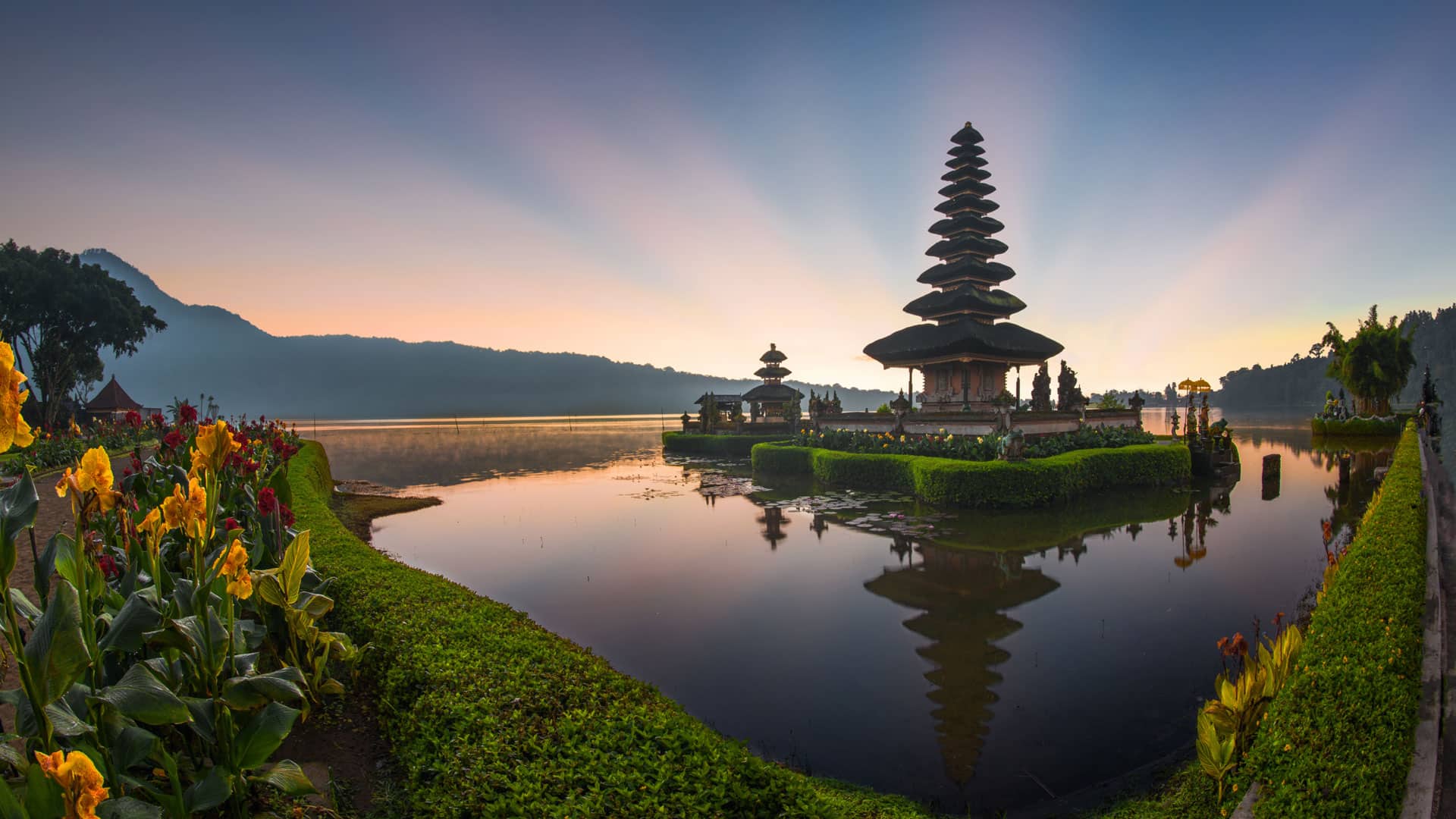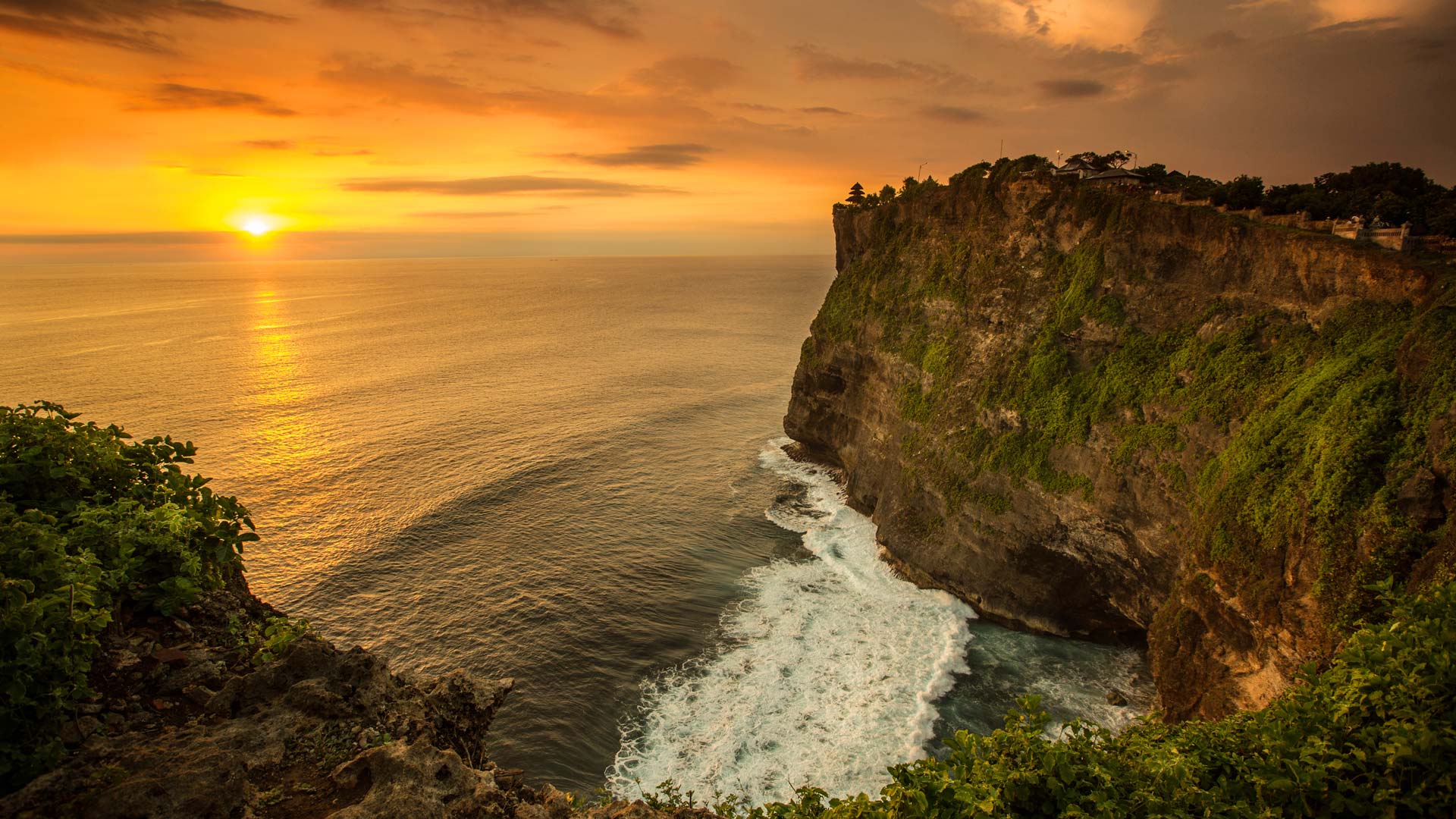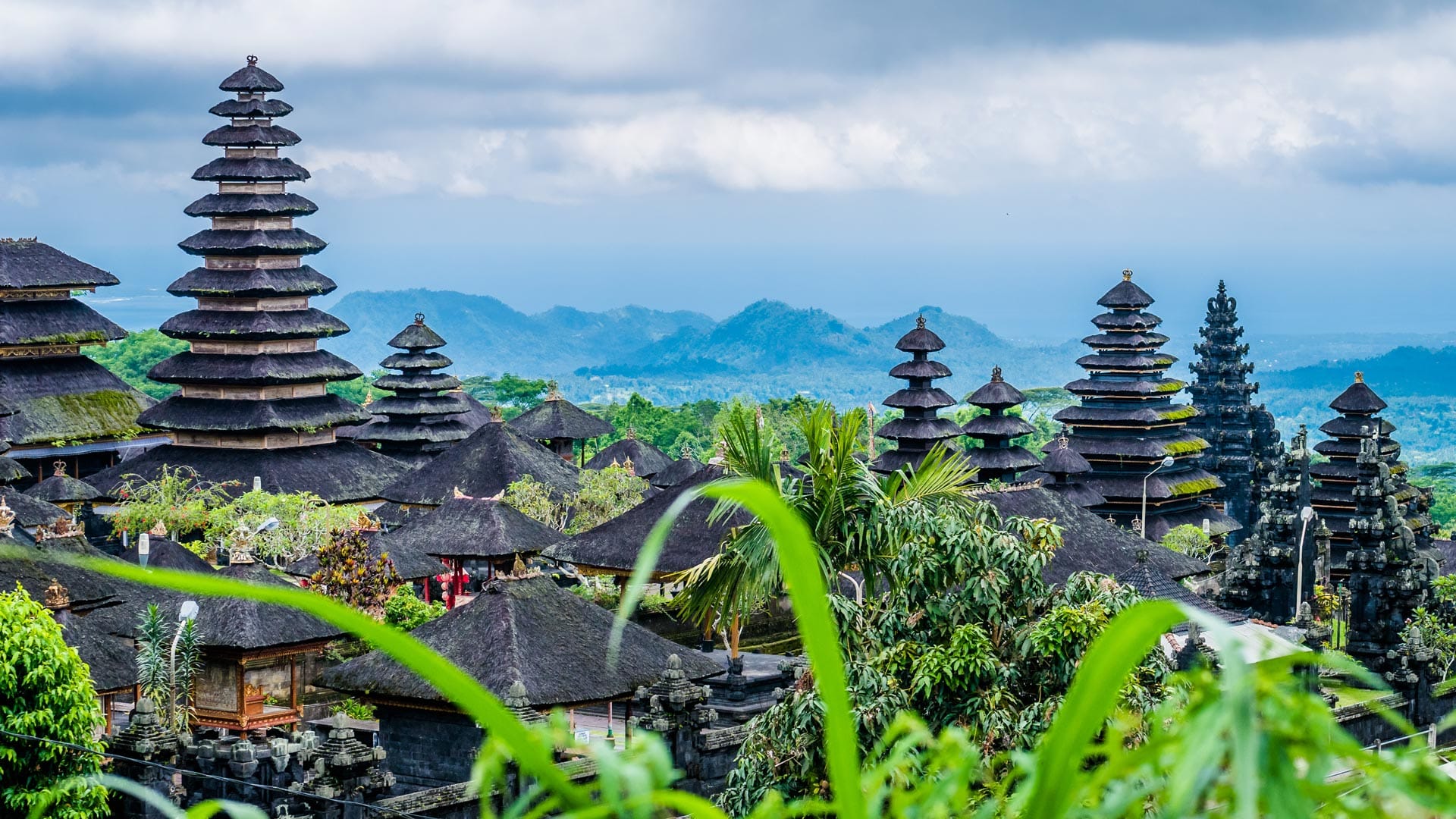
Pura Tanah Lot
As one of the six cardinal temples of Bali, and one of the most scenic, Pura Tanah Lot holds its own as Bali’s most visited temple. You may have seen it before on postcards and in guidebooks, with its multi-tiered meru (pagodas) perched on a rocky outcropping in the sea, highlighted against the hazy hues of the sunset. The temple is not only scenic, but also shrouded in intriguing history and legend.
Tanah Lot was founded by the Javanese priest Danghyang Nirartha in the 16th century. Legend has it that he slept on the site one evening, and afterwards suggested that the Balinese build a sacred temple on that spot. The temple is one of the six cardinal temples in Bali that are strung out in a line down the west coast, and on a clear day you can see all the way to another cardinal temple, Pura Uluwatu on the southwestern coast of the Bukit Peninsula. As one of Bali’s many sea temples that are meant to honor the gods and goddesses of the ocean, this is a sacred site that is revered by many Balinese Hindus.
The name Pura Tanah Lot means ‘temple of the sea and the earth’, and once there it is easy to see why. The temple was built on top of jagged rocks just off the coast, and it is only accessible at low tide, when a footpath appears along the sand and out to the rocks. Inside, there are two pavilions and two shrines with a 7-tiered meru and a 3-tiered meru.
Locals believe that the temple is protected by small poisonous black and white sea snakes as well as one giant snake, all of which were originally Niratha’s sashes that fell into the sea when he left the sacred spot. Another legend says that unmarried couples who visit the temple will break up soon afterwards, which is perhaps why you will never see young Balinese couples visiting the site.
The best time to visit Pura Tanah Lot is at sunset, when the temple is particularly enchanting in the late afternoon and early evening light. However, this is also the time when hordes of tourists descend on the beach to snap shots of Bali’s most photographed temple. If you prefer a quieter experience then arriving early morning would be best. It should also be noted that non-Hindu tourists are not allowed inside the temple at any time. In light of this, it may be a good thing that there are so many small warungs and shops lining the path down to the beach, so you can get in some snacking and shopping in addition to a few shots of the temple. You can even find an ATM here in case you’re short on cash.
To get to Tanah Lot, head along the road that follows the coast west of Kerobokan. There are numerous signs that point you in the right direction, so it should be difficult to miss the turnoff to the temple parking lot. Tickets to Pura Tanah Lot cost 60,000 Rp per adult and 30,000 Rp per child. Parking is an additional 5,000 Rp.

Ulun Danu Beratan Temple
If you’ve ever been captivated by photos of a tiered Balinese temple seemingly floating on water, framed by mountains and a bright blue sky, chances are you were looking at Ulun Danu Beratan Temple. This iconic structure is one of Bali’s most important temples, second only to the Mother Temple of Besakih.
Built in the 17th century, Ulun Danu Beratan is located on the shores of Lake Beratan in the highlands of Bedugul, a cool and misty region in central Bali. The temple is dedicated to Dewi Danu, the goddess of lakes and rivers, who is deeply revered by Balinese Hindus for providing water essential for agriculture across the island.
Ulun Danu Beratan is made up of several shrines and meru (multi-tiered pagodas), many of which appear to float on the lake when water levels are high. The most recognizable structure is the 11-tiered meru, dedicated to Dewi Danu. Nearby are other shrines and merus dedicated to gods associated with mountains and prosperity, including a 3-tiered meru for the goddess who protects crops from disease and shrines honoring local deities and ancestors.
Unlike other temples in Bali, Ulun Danu Beratan combines Hindu and Buddhist elements, including a Buddhist stupa near the entrance. The temple complex is entered through a traditional Balinese candi bentar (split gate), just past a sacred banyan tree. Small warungs around the entrance sell local snacks and drinks to visitors.
The temple plays a vital role in Bali’s subak irrigation system, which relies on water from Lake Beratan. Numerous ceremonies are held throughout the year to honor Dewi Danu and give thanks for agricultural abundance and economic well-being.
During temple anniversaries (odalan), Ulun Danu Beratan comes alive with color as the shrines are adorned in vibrant cloth and parasols, and thousands of Balinese Hindus gather for prayer. Visitors are welcome year-round but should dress modestly: clothing should cover shoulders and knees, and a temple sash should be worn. As per Balinese custom, women who are menstruating are not allowed to enter temple grounds.
The entrance fee is 75,000 Rp for adults, 50,000 Rp for children, with parking at 10,000 Rp for cars and 5,000 for scooters.

Pura Luhur Uluwatu
Pura Luhur Uluwatu is one of the most spectacular temples in Bali, as it sits directly on the edge of steep cliffs that plunge into the Indian Ocean on the southwest coast of the Bukit Peninsula. This is a great place to visit during the late afternoon, because from different vantage points you can see the dramatic tiers of the meru, or pagoda, soaring above the cliffs and silhouetted against the reds, pinks and oranges of the sun as it sinks into the crashing waves of the ocean.
The temple was originally built by the Javanese priest Empu Kuturan in the 11th century, and it is considered to be one of the nine directional temples in Bali that protects the island and its inhabitants from evil spirits. It is also one of many temples built along the coast to honor the gods of the sea. In the 16th century, another Javanese priest named Nirartha expanded the temple, and he eventually came to live here at the end of his life. Legend has it that he attained moksa, or liberation from earthly desires here.
To enter the temple, pass through the looming candi bentar, the split level gates that were carved to represent the wings of the god Garuda. The second gate is an archway with Ganesha statues on either side. Inside the temple compound, the dark gray coral stone walls have remarkably well-preserved Hindu mythological carvings, and the stone pathways make their way along the edges of the cliffs, offering incredible views out to sea. The inner temple is only open to Hindu worshippers, however, non-Hindu guests are free to roam the other areas of the temple.
Throughout the temple, you will come across families of monkeys who live in the compound. Be very careful with your belongings, as the monkeys love to grab hats, jewelry, handbags, and of course, food. Once they have what they want, they will be gone in the blink of an eye, so you can say goodbye to your wallet or that new camera. They also have no qualms about jumping on people large and small, so it is best not to give them a reason to do so.
One of the biggest attractions to Pura Luhur Uluwatu is the Kecak and fire dance that takes place inside the temple compound every night at sunset. Tickets are 150,000 Rp per person, and well worth the price for this stunning performance. The Kecak dance is performed by a circle of men who use their voices to create a mesmerizing harmony, while at the same time waving their arms and hands to create fluid movements around the circle. Then, the elaborately attired dancers enter the circle to act out a scene from the epic Ramayana story. The whole dance ends with a fire display as the sun sets in the background.
The entrance fee for Pura Luhur Uluwatu is 5,000 Rp for parking, and 50,000 Rp per person, which includes the rental of a sarong and sash. Please dress respectively, with knees and shoulders covered for both men and women. Singlets, bikini tops, or revealing dresses, skirts or shorts are not appreciated. Also, be aware that in Bali, women who are menstruating are not allowed to enter any temple.
*Note: Tickets for the performance are separate from the temple entrance fee and can be purchased on-site or through authorized vendors.

Besakih – The Mother Temple
Bali’s biggest and most sacred temple by far is Besakih, otherwise known as the ‘Mother Temple’. Located at 900 meters up the steep slope of the sacred volcano Mount Agung, this stunning complex of 22 temples is revered by the majority of Balinese Hindus, and a site of many elaborate rituals and ceremonies. Even when there are no auspicious days or holy rituals, the temple is packed with Balinese who come to pray at the shrines and collect sacred holy water from the Mother Temple that is used in ceremonies around the island.
Besakih centers around the main enclosure, which is called Pura Penataran Agung. This temple is made up of six levels that make their way up the slope of the volcano, and where you can see the lofty carved stone gates (candi bentar) that appear on so many postcards and tourist brochures about Bali. Pura Penataran Agung dates back to the prehistoric era when it was a small shrine, and over the centuries it has evolved into what you see today. The temple is made up of the lotus throne, with three seats dedicated to Brahma, Siva and Wisnu, as well as other shrines for important Hindu deities. It is important to note that visitors are not allowed in this temple, although you can catch glimpses of the temples and shrines from different points around the temple.
Visitors can explore the different areas of the sprawling Besakih temple complex, although there are many village and clan temples that are not open to tourists. Keep in mind that you must dress and act respectfully when visiting this sacred temple. Both women and men should wear a sarong that covers the knees, as well as shirts that cover the shoulders and a sash. If you really want to show respect, you can wear the traditional pakaain adat, or ceremony attire of a kebaya and sash for women and an udeng, or headpiece for men. Do not venture into temples that are not marked as open to tourists, and never intrude upon a ceremony or ritual unless invited. Also, be aware that in Bali, women who are menstruating are not allowed to enter any temple.
Another thing to be aware of is the sheer number of touts that hang around the main parking area trying to solicit guests. Avoid aggressive “guides” near the entrance who may claim you need their services or promise access to restricted areas. These are often unofficial and can pressure tourists. Stick to the official guide team included with your entrance ticket for a respectful and smooth experience.
The cost to enter is 150,000 Rp per person, which includes sarong rental, official local guide and one-way shuttle ride (transportation from the parking area to the main temple entrance). The parking fee is 10,000 Rp for cars and 5,000 Rp for scooters/motorbikes.
Planning Your Stay in Bali
To discuss planning your stay with one of our villa specialists, please get in touch.

